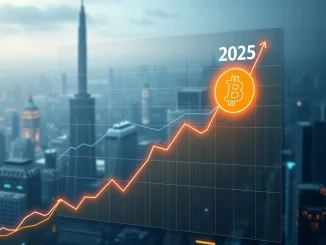
Bitcoin has once again captured the world’s attention, demonstrating its remarkable resilience and growing influence in the global financial landscape. In a significant move, the premier cryptocurrency has surged past the formidable $118,300 mark, leaving investors and analysts buzzing. This latest Bitcoin price surge isn’t happening in a vacuum; it’s intricately linked to a complex web of global trade dynamics, shifting tariff uncertainties, and an undeniable increase in institutional Bitcoin demand. Let’s dive into the factors propelling Bitcoin’s ascent and what they mean for the future of crypto market trends.
Understanding the Global Tariff Impact on Bitcoin
The global economic stage is currently dominated by intricate trade negotiations, and their outcomes are directly influencing risk appetite across markets, including cryptocurrencies. Recent developments, such as the U.S. reaching a trade agreement with Japan, have injected a degree of optimism. However, the shadow of potential high tariffs, particularly from former President Trump’s threats on nations restricting market access, continues to cast volatility over global markets. Analysts suggest that the potential resolution of these tariff-related risks has significantly bolstered ‘risk-on’ sentiment, a key driver for Bitcoin’s rally.
A critical focal point remains the U.S.-EU tariff standoff. Reports indicate a potential breakthrough, with the European Union considering a proposal for a 15% tariff on certain goods, a considerable reduction from the previously anticipated 30%. Mutual concessions on key sectors like aircraft and medical devices are also on the table, aimed at easing long-standing tensions. However, the clock is ticking. Without a resolution by August 1st, retaliatory measures – including a potential 30% U.S. tariff and a staggering $93 billion in EU retaliation – could ignite a full-blown trade war, plunging markets back into uncertainty.
Current EU exporters are already grappling with a 10% customs tax and an additional 4.8% levy, underscoring the urgency for a resolution. A key compromise being eyed is the reduction of the hefty 27.5% car tariff to 15%. While no concrete agreement has materialized yet, the mere prospect of reduced trade friction is a powerful catalyst for investor confidence, contributing to the broader positive crypto market trends we’re witnessing.
Why Are US-EU Trade Talks So Crucial for Bitcoin?
The direct correlation between major geopolitical events and Bitcoin’s price action highlights its evolving role as a macroeconomic barometer. Here’s why the U.S.-EU trade talks are particularly significant:
- Risk-On Sentiment: A resolution to trade disputes reduces global economic uncertainty, encouraging investors to move into riskier assets like Bitcoin, rather than seeking safe havens in traditional assets.
- Economic Stability: Stable trade relations foster economic growth and predictable market conditions, which are generally favorable for investment across the board, including digital assets.
- Currency Dynamics: Trade tensions can lead to currency fluctuations. Bitcoin, as a decentralized asset, can sometimes act as a hedge against such volatility, attracting investors looking for alternatives.
- Investor Confidence: Positive outcomes in major trade negotiations signal a healthier global economy, boosting overall investor confidence and encouraging capital flow into promising assets like Bitcoin.
The Rise of Institutional Bitcoin Demand
Beyond global trade, a foundational pillar supporting Bitcoin’s current strength is the undeniable surge in institutional Bitcoin demand. July 2025 has been a testament to this, with significant acquisitions and strategic moves by major players:
- Strategy Inc. Acquisition: A notable example is Strategy Inc.’s acquisition of a staggering 3% of the global Bitcoin supply. This monumental purchase signals profound confidence in Bitcoin as a long-term store of value and a strategic asset.
- Trump Media’s Reserve: Trump Media’s allocation of a $2 billion reserve into Bitcoin further underscores the growing acceptance and integration of cryptocurrency into corporate treasuries.
- Regulatory Progress: The continuous progress in regulatory frameworks, particularly U.S. legislation for stablecoins, adds a layer of legitimacy and security to the broader crypto ecosystem. This regulatory clarity makes it easier for institutions to participate, reducing perceived risks.
- Macroeconomic Tailwinds: The Bank of Japan’s liquidity measures and broader global accommodative monetary policies are creating an environment where traditional assets yield less, pushing institutions to seek higher returns in alternative assets like Bitcoin. This hunt for yield is a significant driver of the current Bitcoin price surge.
These developments are not isolated incidents but part of a broader trend where institutional capital is increasingly recognizing Bitcoin’s potential. This influx of sophisticated investors brings greater liquidity, stability, and credibility to the market, distinguishing it from earlier, more retail-driven cycles.
What Do Current Crypto Market Trends Tell Us?
While Bitcoin’s price briefly touched an impressive $123,000, it has since seen some short-term volatility, retreating to around $117,900 amid profit-taking. This is a natural part of market cycles and does not diminish the underlying bullish fundamentals. The current consolidation phase around the $115,000–$120,000 range is a critical psychological threshold. Its ability to hold this level will likely dictate its trajectory in the coming weeks.
Another key indicator is Bitcoin’s dominance, which remains above 70%. This high dominance suggests that while Bitcoin is thriving, altcoins are currently experiencing a lack of significant momentum. This often indicates a ‘risk-off’ sentiment prevailing in the broader crypto market, where investors prefer the relative safety and established liquidity of Bitcoin until broader uncertainties, especially those related to trade, abate. As BitMEX co-founder Arthur Hayes suggests, a global easing cycle, driven by central bank decisions, could significantly amplify Bitcoin’s gains, provided there’s clarity on trade policies.
The interplay between geopolitical developments, macroeconomic policies, and the burgeoning institutional interest is painting a compelling picture for Bitcoin. While short-term fluctuations are inevitable, the long-term outlook appears robust, supported by strong fundamentals and increasing mainstream acceptance.
The Road Ahead: Navigating Volatility with Confidence
Bitcoin’s journey has always been characterized by its dynamic response to global events. The current surge, driven by the intricate dance of U.S.-EU trade talks, the potential for reduced global tariff impact, and the undeniable force of institutional Bitcoin demand, underscores its maturing role as a significant player in the global financial ecosystem. As market participants keenly observe the unfolding trade negotiations, their outcomes will undeniably shape Bitcoin’s near-term direction. A successful resolution with the EU could alleviate economic tensions, stabilize risk appetite, and provide a clear runway for further growth. Conversely, unresolved disputes could reintroduce volatility.
Despite the ebb and flow of market sentiment, the foundational support from increasing institutional adoption and progressive regulatory developments provides a strong bullish undercurrent. Bitcoin continues to prove its mettle, adapting to and often leading the charge in an ever-evolving global economy. Its ability to act as a barometer for macroeconomic shifts, coupled with its growing appeal to sophisticated investors, positions it as a vital asset to watch in the coming months.
Frequently Asked Questions (FAQs)
Q1: Why did Bitcoin surge past $118,300 recently?
Bitcoin’s recent surge is primarily attributed to a combination of factors: positive shifts in global trade dynamics (particularly optimism around U.S.-EU trade talks), the potential removal of tariff-related risks, expectations of falling interest rates, and significant institutional Bitcoin demand, including large acquisitions by major firms.
Q2: How do global trade talks and tariffs affect Bitcoin’s price?
Global trade talks and tariffs significantly impact market sentiment. When trade tensions ease, it boosts ‘risk-on’ sentiment, encouraging investors to allocate capital to riskier assets like Bitcoin. Conversely, heightened trade wars and tariff threats introduce uncertainty, which can lead to volatility or a ‘risk-off’ approach, where investors might temporarily retreat from risk assets.
Q3: What is ‘institutional Bitcoin demand’ and why is it important?
Institutional Bitcoin demand refers to large-scale investments in Bitcoin by corporations, asset managers, and financial institutions. It’s important because it brings significant capital, increased liquidity, and greater legitimacy to the cryptocurrency market, helping to stabilize prices and reduce volatility compared to retail-driven markets.
Q4: What role do macroeconomic policies play in Bitcoin’s performance?
Accommodative macroeconomic policies, such as central bank liquidity measures (e.g., Bank of Japan) and expectations of falling interest rates, tend to benefit Bitcoin. These policies often lead to lower returns in traditional investments, prompting investors to seek higher yields in alternative assets like Bitcoin.
Q5: Is Bitcoin’s high dominance (above 70%) a good sign for altcoins?
Bitcoin’s dominance above 70% generally indicates a ‘risk-off’ sentiment in the broader crypto market. While good for Bitcoin, it often suggests that altcoins are not experiencing significant momentum. Investors prefer the relative safety and liquidity of Bitcoin until broader market uncertainties, particularly those related to global trade, abate, potentially signaling a future ‘altcoin season’ when confidence returns.



